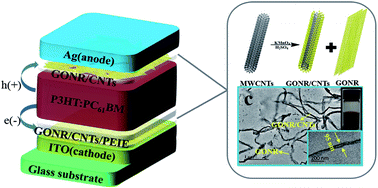One-dimensional graphene nanoribbons hybridized with carbon nanotubes as cathode and anode interfacial layers for high performance solar cells†
Abstract
Solution processible graphene oxide nanoribbons (GONRs) with a continuous one-dimensional length and the remaining carbon nanotubes (CNTs) have been synthesized from the partial unzipping of multiwalled carbon nanotubes (MWCNTs). Such low-cost GONRs hybridized with CNTs (GONR/CNTs) show solution processibility as well as a tunable work function and multifunctional interfacial modification in polymer solar cells (PSCs) due to well-defined nanoribbons containing CNTs with a continuous one-dimensional length that promote charge transport, different from the GONRs unzipped from single-walled carbon nanotubes that tend to form a large amount of graphene oxide pieces. Incorporation of the GONR/CNTs into solution processed PSCs as an electron transporting layer (ETL) and hole transporting layer (HTL) simultaneously delivers a high device performance with long-term stability. The results demonstrate that multifunctional GONR/CNTs unzipped from MWCNTs would be promising interfacial materials for solution processed high performance PSCs.


 Please wait while we load your content...
Please wait while we load your content...